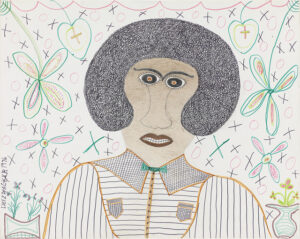Today’s post comes from Olivia Zisman, class of 2016 and Art Center Student Docent.

When I walk through the Frances Lehman Loeb Art Center’s 20th Century gallery, Louise Nevelson’s Dawn’s Wedding Feast Columns always draw my attention. The monochromatic white sculptures seem to have an almost ethereal, otherworldly quality, standing enigmatically side-by-side and larger than life.
The artist originally created these white sculptures in 1959 as part of a room-sized installation for the exhibition Sixteen Americans at the Museum of Modern Art in New York. Dawn’s Wedding Feast included the Loeb’s columns (representing wedding attendants), four wedding chapels, a cake, chest, mirror, pillow, and bride and groom, all made out of assembled wooden forms and painted white. This white assemblage was unique for Nevelson who had worked with a mostly monochromatic black palette before this piece. According to the artist, the color black gave her sculptures a weighty sense of monumentality; as she noted, “for me, the black contains the silhouette, the essence of the universe. But the white moves out a little bit into outer space with more freedom.” In this way, it is possible that Dawn’s Wedding Feast represented a change in Louise Nevelson’s viewpoint. Nevelson created the installation in the aftermath of her divorce from her husband, so this work can be interpreted as a clean new beginning for the artist.
The individual wooden pieces making up the columns lose their recognizable identities when carefully pieced together by Nevelson, in much the same way that the two columns take on a new identity when removed from their original environment. Although I can never seem to fully identify the individual materials Nevelson has used, when I look at these individual materials as parts of the whole, the sculpture gains a much deeper meaning for me. The two columns seem to interact with one another, as might guests at a wedding, representing human connection and the new beginning that a wedding brings.
On their own, the columns lose the original intent of the artist, but I don’t believe this is necessarily a bad thing. Now, in interacting with these sculptures on their own, viewers are able to create their own intent for the work by examining and questioning Nevelson’s artistic choices. In their new environment, Dawn’s Wedding Feast Columns are up for interpretation, and allow the viewer to interact with this work in a more personal way.





Interesting pieces. But I think Brancusi is better.
Good Site! I am going to visit everyday. Best regards